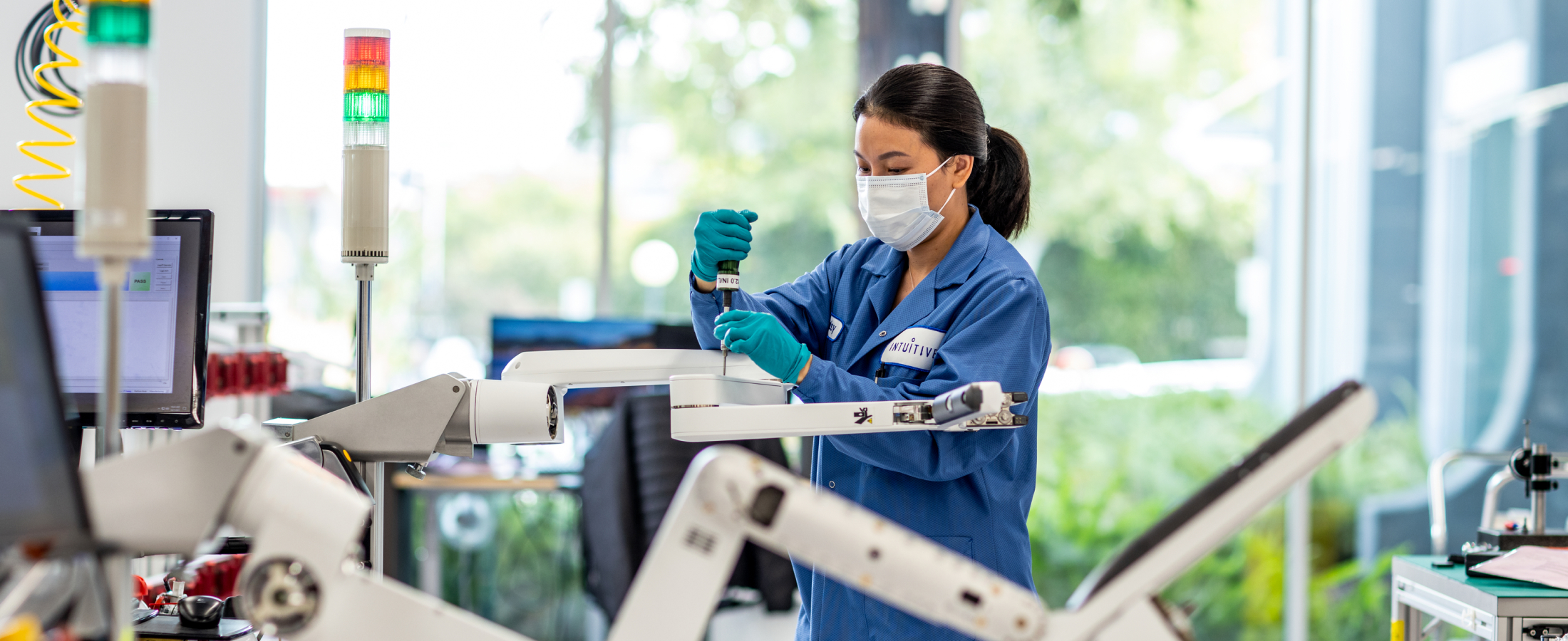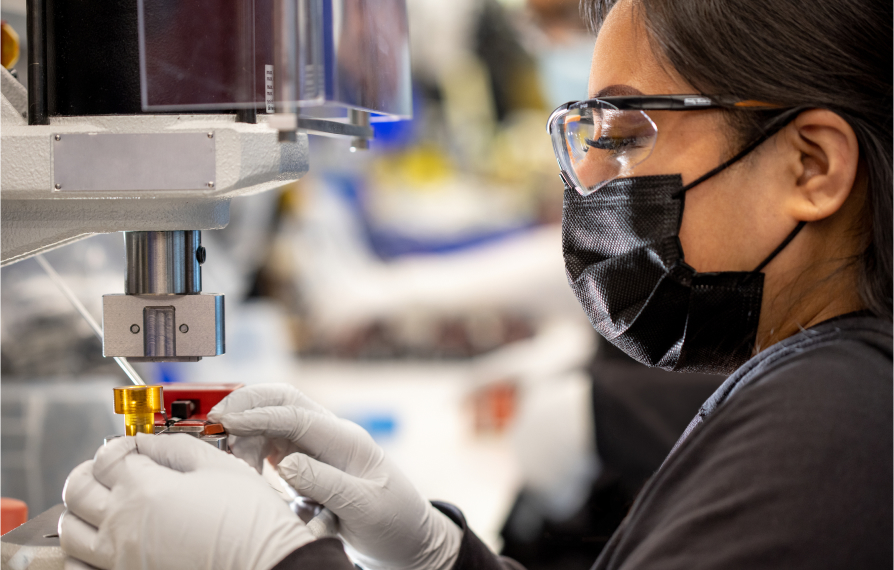

For over 25 years, Intuitive has focused on innovating for minimally invasive care for hospitals, physicians, and the patients they serve.
We manufacture the three components of the da Vinci Xi and da Vinci SP systems at Intuitive’s Sunnyvale campus: the surgeon console, the patient side cart, and the vision cart.
Rolando Zamora has been with Intuitive for over thirteen years—many of them as the Supervisor of the Manufacturing Training Group.
He speaks of the passion and goal to build a product that hospitals can trust and rely on to succeed with their patients.
“There is a sense of trust that they can have in us, the reliability and durability of the system by virtue of the way we manufacture it,” Zamora said.
In training new employees, Zamora underscored Intuitive’s commitment to patients first, always.
“I teach each individual to build a system as if it is to be used on a friend, a family member, a loved one, or even yourself. That’s the passion we try to instill on the manufacturing floor.”
Intuitive teaches technicians lean manufacturing standards: the use of standards, principles, and practices that focus on eliminating waste in order to improve productivity and efficiency. Intuitive goes to great lengths to engineer quality into its manufacturing processes to ensure that each step adds value to the product, delivers high-quality, and ultimately results in a high standard of patient care.
“We not only talk about it,” Zamora said. “We teach it, we train it, we support it, and we practice it.
There are over 7,600 fasteners in a da Vinci Xi system installed by hand. Each screw is fully seated and 100% verified with precision computer-based torque drivers. This process records a digital ‘signature’ of each screw, with electronic records maintained in a device history database.
Mike Prindiville is Vice President of Process Engineering; he’s worked with Intuitive for 21 years. Prindiville’s role is specific to multiport systems—the da Vinci X and Xi systems, and their associated instruments and cameras.
“I have one foot in the factory, and the other in design,” Prindiville said. “We help ensure that we have tooling and production lines and process flows—the supply chains in place to successfully build the variety of our products at volume. We like to say, ‘We build the robots that build the robots.’”
Robotics is the integration of many different technologies.
“It includes mechanisms, mechanical components, as well as software, electronics, sensors, motors, circuit boards, cable harnesses—and bringing all those technologies together in a consistent and reliable, safe method, over and over and over again. Our goal is to make what’s complex, simple.”
Engineers have their own language, and robotics engineers are no exception.
“Have you heard that the Inuit language has over 100 words for ice?” Prindiville asked. “We would say the same for the word friction, in our language at Intuitive.”
Intuitive manufactures hundreds of different products: everything from a da Vinci system itself, which contains thousands of components and takes several weeks to build, to an individual accessory like a seal—which might contain less than a dozen components and can be built in seconds.
Prindiville speaks to the teamwork and process of the labs.
“The labs are where the magic happens. It’s space that’s designed to be collaborative: there are workbenches with all the tools needed for assembling prototypes—or even breaking prototypes.”
Each full da Vinci system is tested for a minimum of 96 hours. The data for each and every measurement is collected and analyzed by the manufacturing design engineering chain to catch any shift in performance.
“An individual da Vinci system has about 3,800 test points,” Prindiville said. “If you bring your car into a repair shop, they might do a 50- or 100-point inspection. We’re doing a 3,800-point inspection. So, it’s certainly very thorough.”
In the process of testing systems—and each individual part—anything that is out of the ordinary is immediately subject to attention that some would say borders on obsessive.
“At the factory, some of the robotic axes (or degrees of freedom) had increased friction. We started systematically dissembling some of the components, looking for the source of this friction.
“The whole factory stopped, and we had a lot of people trying to figure out if they could help or what we could do. We brought some of the design engineers out from their desks to help us. We had a good unit and a suspect unit side by side. And we were swapping the parts and trying to really tease out the differences.”
The engineers were examining a product made of thousands of components and had ultimately narrowed it down to a single part: one bearing.
“We were looking at the bearing and taking some measurements,” Prindiville explained. “One of the engineers came out and said, ‘Smell this bearing… they smell different.’ And there we were, sniffing the bearings.
“Sure enough, the good bearing and bad bearing smelled different. It was the last thing. We had measured everything, taken pictures—we just hadn’t sniffed it. Said simply, the grease had changed. We solved it by someone just noticing that the smell was different.”
In the final integration, a technician connects the three components of the system and tests it for the very first time as a surgical system.
Test technicians perform three surgical procedures on simulated models for a final quality inspection. The dexterity and command of the system is tested, ensuring it is articulating in the correct manner for the doctor in a surgical setting.

Every component of the system must work in unison: the surgical platform, the instrumentation, the vision system, the software.
Prindiville talks about walking the assembly lines in the systems factory and watching the testing processes fall into visual synchronicity.
“A da Vinci system has 75 degrees of freedom, and they’re all moving concurrently as part of our test processes. We call it ‘dance.’ You look across the factory floor and you may have 10, 20 systems that are all in dance at the same time, and it’s really a beautiful thing to see—75 axes of motion, repeated 20 times. It’s very artful.”
Like a lot of engineers, Prindiville is excited by the potential emergence of a problem to solve.
“Certainly it’s what gets me excited,” he said. “I always sort of hope that there will be this day where we solve the last problem. But the reality is, the more our business grows and scales, the more challenges there are to be solved. The really hard challenge is not ‘how do you solve a problem?’ but ‘how do you avoid the problem to begin with?’”
Important safety information
For important safety information, please refer to www.intuitive.com/safety. For a product’s intended use and/or indications for use, risks, full cautions, and warnings, please refer to the associated User Manual(s).